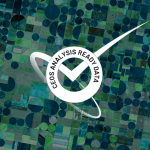New CEOS-ARD Product Family Specifications
Two new CEOS Analysis Ready Data (CEOS-ARD) Product Family Specifications (PFS) have recently been endorsed: Nighttime Lights Surface Radiance & Ocean Radar Backscatter. This brings the total number of PFS to seven, covering both optical and radar products and across land and oceans.
Ocean Radar Backscatter (ORB)
The Ocean Radar Backscatter (ORB) PFS is derived from the Normalised Radar Backscatter (NRB) product and is tailored specifically for ocean applications. These products are simplified to a degree, as a Digital Elevation Model (DEM) is not applicable. Other changes relative to the NRB PFS are the inclusion of a geoid incidence angle image and land mask.
The ORB product specification has been subject to Geoid Correction and is provided in the sigma nought (0) backscatter convention, which is recommended for most ocean applications. Speckle filtering has not been applied to the ORB product in order to preserve spatial resolution and user freedom. As with the other radar PFS, the ORB PFS is also accompanied by a metadata specification.
This work was coordinated by the European Space Agency (ESA), led by Clément Albinet, with contributions from the following team:
- Bruce Chapman, NASA/JPL, USA
- François Charbonneau, Natural Resources Canada, Canada
- Guillaume Hajduch, Collecte Localisation Satellites, France
- Muriel Pinheiro, ESA, Italy
- Ake Rosenqvist, soloEO for JAXA, Japan
- HariPriya Sakethapuram, ISRO, India
- David Small, University of Zurich, Switzerland
- Takeo Tadono, JAXA, Japan
- John Truckenbrodt, DLR, Germany
- Antonio Valentino, RHEA for ESA, Italy
- Anna Wendleder, DLR, Germany
- Fang Yuan, Digital Earth Africa, Australia
- Zheng-Shu Zhou, CSIRO, Australia
Nighttime Lights Surface Radiance (NLSR)
The Nighttime Lights Surface Radiance PFS was coordinated by Brian Killough (CEOS SEO, NASA) with technical support from Miguel Román (Leidos) and Zhuosen Wang (NASA GSFC). The Nighttime Light Surface Radiance PFS utilises features of the existing Surface Reflectance PFS with the primary differences in development accounting for lunar radiance and atmospheric scattering. This PFS applies to data in the visible and near-infrared wavelengths, with NASA’s Black Marble being a prime example dataset. The NASA Black Marble dataset is currently undergoing self-assessment, with the goal to be certified as the first Nighttime Lights CEOS-ARD in the near future.

